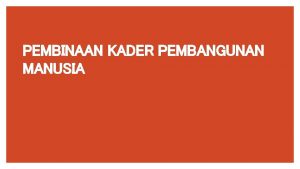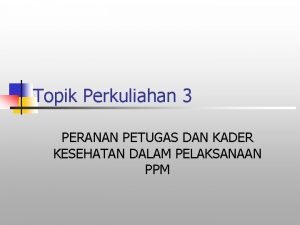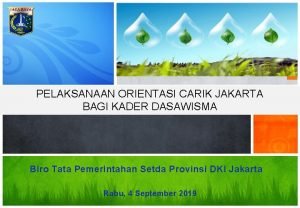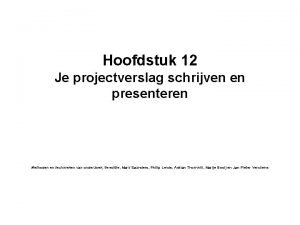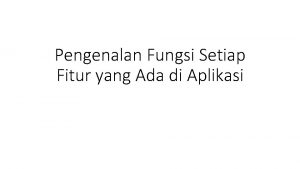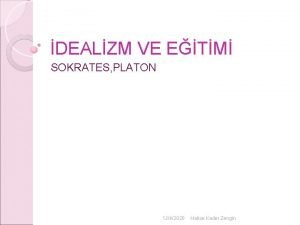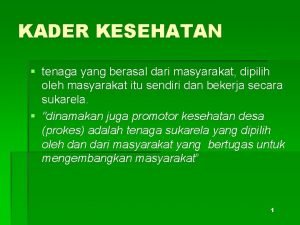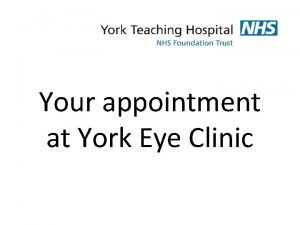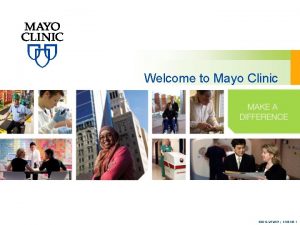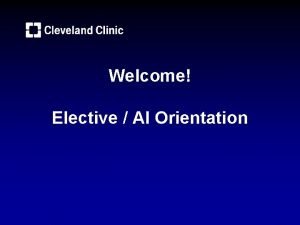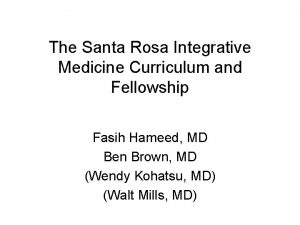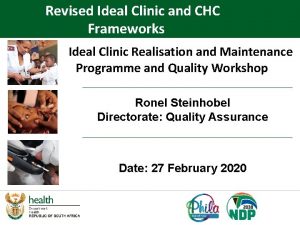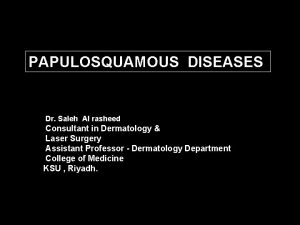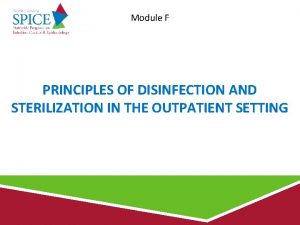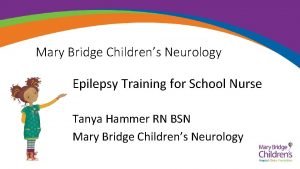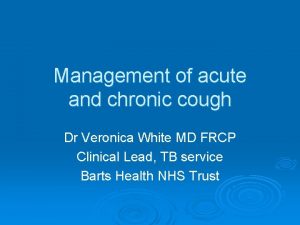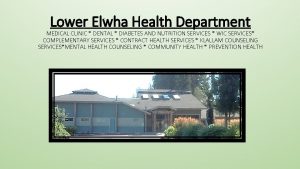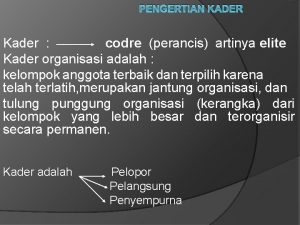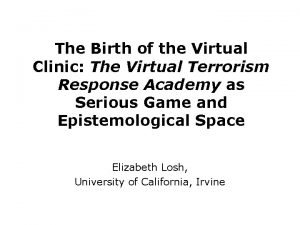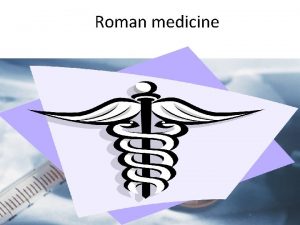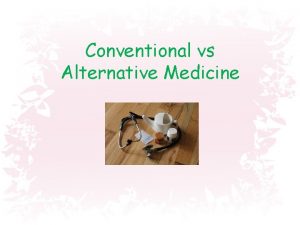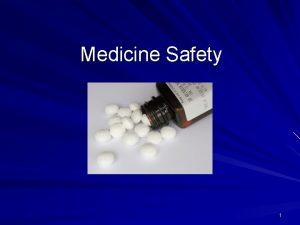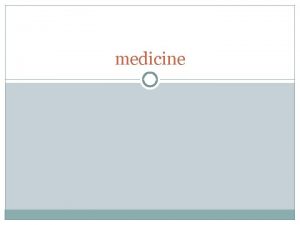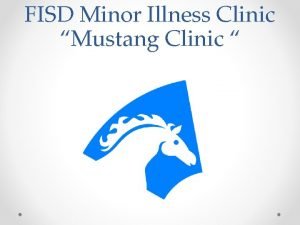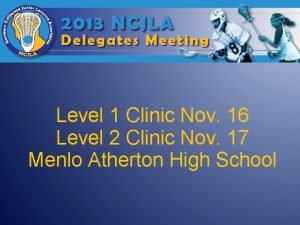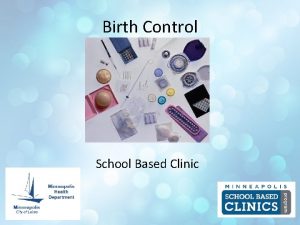VIRTUAL MEDICINE A CLINIC DAY WITH DR KADER

















































- Slides: 49

VIRTUAL MEDICINE A CLINIC DAY WITH DR KADER 2020 TECHNOLOGY CASES UPDATE

Relationships with commercial interests: Grants/Research support NOVONORDISK; SANOFI; Speaker’s bureau/honoraria: DEXCOM; ANIMAS; MEDTRONIC; ELI LILLY NOVORDISK; BI ; SANOFI; ABBOTT; MERCK; ASTRAZENECA Consulting/Advisory Board: SAME AS ABOVE Other/Patents Presenter Disclosure

HOW MANY PATIENTS A WEEK DO YOU SEE TYPE 1 DIABETES OR TYPE 2 DIABETES • A) 0 TO 5 • B) 5 TO 10 • C) 10 TO 15 • D) OVER 15

IS VIRTUAL MEDICINE HERE TO STAY A) YES B) NO

TOOLS FOR VIRTUAL MEDICINE • DO YOU USE PLATFORMS FOR YOUR DIABETES PATIENT; SO YOU CAN SEE THEIR DATA • A) YES • B) NO

HAVE YOU HEARD OF • DEXCOM CLARITY • A) YES • B) NO • LIBREVIEW • A) YES • B) NO

WOULD YOU BE INTERESTED IN LEARNING MORE ABOUT THESE PLATFORMS • A) YES • B) NO TAKES TOO MUCH TIME • C) TEACH ME ABOUT IT AND MAYBE WOULD INCORPORATE IT

TECHNOLOGY AND DIABETES This Photo by Unknown Author is licensed under CC BY-NC


The Free. Style Libre system and Libre. View support telemedicine, enabling HCPs to effectively monitor multiple people with diabetes under their care For people with diabetes, the Free. Style Libre system: Is convenient, easy to use and removes the need for routine finger-prick* testing Helps understand impact of medication, food, and activity on their glucose patterns Empowers self management of glucose patterns *Finger pricks are required if glucose readings do not match symptoms or expectations For clinicians, Libre. View is a user-friendly dashboard that: Provides access to standardised reports containing comprehensive glucose information needed inform disease management Allows real-time analysis of data from multiple people with diabetes under their care Provides a platform for care team collaboration Sensor-based glucose monitoring using the Free. Style Libre system offers a complete glycemic picture to help patients and clinicians make more informed diabetes management decisions, across both primary and secondary care 1, 2 HCP = healthcare professional 1. Kudva YC et al. 2018. “Approach to Using Trend Arrows in the Free. Style Libre Flash Glucose Monitoring Systems in Adults. ” Journal of the Endocrine Society 2 (12): 1320– 37. https: //doi. org/10. 1210/js. 2018 -00294; 2. Unger J et al. 2020. “Practical guidance for using the Free. Style Libre flash continuous glucose monitoring in primary care. ” Postgraduate Medicine, 1– 9. Advance online publication. https: //doi. org/10. 1080/00325481. 2020. 1744393 Proprietary and confidential — do not distribute

CHALLENGES OF MANAGEMENT DIABETES • EXPECTATIONS for patients • UNDERSTANDING FLASH MONITORING VERSUS FINGERSTICK • UNDERSTANDING THAT NO 2 DAYS ARE THE SAME AND THAT SUGARS LIKE LIFE CHANGES FROM DAY TO DAY • FRUSTRATIONS ON BOTH MD AND PATIENT SIDE • MY MOTO; MY PATIENTS LIVE THE LIFE AND THE DOCTORS GETS TO SEE MANY DIFFERENT EXAMPLES; WE WORK TOGETHER AS A TEAM

Dr Kader’s clinical experience on telemedicine Dr Kader’s perspective • TELEMEDICINE: • Since march 2020 • is our new reality • Libre view has been a game changer AND • DEXCOM FOR TYPE 1 AND SOME TYPE 2 • Our patients can upload from home environment and can connect with us at any time • At appointment we go over time in range Proprietary and confidential — do not distribute

Patient education What impacts glucose levels This Photo by Unknown Author is licensed under CC BY

How does food change your glucose? Carbohydrates have the biggest impact on your readings Follow a healthy eating plan February 26, 2021 14

What changes your glucose readings? February 26, 2021 Food Activities Medication Illness Stress Alcohol 15

Let’s take a look at how different breakfast foods can change your glucose NORMAL BREAKFAST February 26, 2021 MORE CARBOHYDRATES FEWER CARBOHYDRATES 16

Exercise can change your glucose too! NORMAL EXERCISE February 26, 2021 MORE EXERCISE LESS EXERCISE 17

Taking your medication as prescribed can change your glucose NORMAL MEDICATION February 26, 2021 MORE MEDICATION LESS MEDICATION 18

BE AWARE OF CHANGING GUIDELINES This Photo by Unknown Author is licensed under CC BY-SA 19

Figure 1: At diagnosis of type 2 diabetes • • GOAL Attain A 1 c target by 3 months If A 1 c NOT at target at 3 months Assess glycemic control, cardiovascular and renal status*, recent dietary patterns and weight change Select individualized A 1 C target (see Chapter 8, 2018 CPG) Provide and/or refer for diabetes education (see Chapter 7, 2018 CPG) Start healthy behaviour interventions (see Chapters 10, 11, 17, 2018 CPG) Lifestyle changes expected to reduce blood glucose levels Start Metformin No pharmacotherapy (If A 1 c>1. 5% above target, Start metformin + a second agents Start Metformin Adjust or advance therapy Symptomatic hyperglycemia and/or metabolic decompensation Start insulin ** + metformin Reassess A 1 c in 3 -6 months (see chapter 9, 2018 CPG) Got to figure 2 Got to figure 3 In individuals with atherosclerotic cardiovascular disease, history of heart failure (with reduced ejection fraction) or chronic kidney disease, agents with cardiorenal benefits (Figures 2 A and 2 B) may be considered (see Pharmacologic Glycemic Management of Type 2 Diabetes in Adults: 2020 Update - The User's Guide). * Unintentional weight loss should prompt consideration of other diagnoses (e. g. type 1 diabetes or pancreatic disease). ** Reassess need for ongoing insulin therapy once type of diabetes is established and response to health behavior interventions is assessed Lipscombe et al. Can J Diabetes 44 (2020) 575 -591 Senior et al. , Can J Diabetes. 2020 Oct; 44(7): 592 -596. A 1 C, glycated hemoglobin; CPG, clinical practice guidelines

Figure 2 A. Reviewing, adjusting or advancing therapy in type 2 diabetes. Regular Review • Assess glycemic control, cardiovascular and renal status • Screen for complications (eyes, feet, kidneys) • Review efficacy, side effects, safety and ability to take current medications • Reinforce and support healthy behaviour interventions If A 1 c NOT at target at 3 months And/or Change in clinical status Adjust or advance therapy* ASCVD, CKD or HF OR Age >60 with 2 CV risk factors + A 1 C above target and glucose lowering required ADD or SUBSTITUTE AHA with demonstrated cardiorenal benefits (See Figure 2 B) ADD or SUBSTITUTE AHA++ according to clinical priorities+++ start insulin for symptomatic hyperglycemia and/or metabolic decompensation (Figure 3) Lower risks observed in clinical trials Established Cardiovascular or Renal Disease ASCVD CKD MACE GLP 1 -RA or SGLT 2 i* or GLP 1 RA HHF SGLT 2 i* Progression of nephropathy SGLT 2 i* Highest levels of evidence *Initiate only if e. GFR>30 ml/min/1. 73 m 2 HF GLP 1 -RA SGLT 2 i* (and lower CV mortality) SGLT 2 i* Grade A Grabe B Risk Factors >60 yrs with CV risk factors+ SGLT 2 i* dulaglutide, liraglutide, semaglutide exenatide ER, lixisenatide SGLT 2 i ertugliflozin*** (SGLT 2 i) canagliflozin, dapagliflozin, empagliflozin DPP 4 i sitagliptin, linagliptin, alogliptin Acarbose SGLT 2 i* Grade C or D PROVEN cardiorenal benefit CV safety, but NO proven in high risk populations** cardiorenal benefit** GLP 1 RA Weight loss RISK of HF saxagliptin (DPP 4 i) Hypoglycemia Sulfonylureas Meglitinides Insulin Thiazolidinediones Weight gain Fixed-dose combinations may be considered to reduce burden *Changes in clinical status may necessitate adjustment of glycemic targets and/or deprescribing; + Tobacco use; dyslipidemia (use of lipid-modifying therapy or a documented untreated low-density lipoprotein (LDL) >3. 4 mmol/L, or high-density lipoprotein-cholesterol (HDL-C) <1. 0 mmol/L for men and <1. 3 mmol/L for women, or triglycerides >2. 3 mmol/L); or hypertension (use of blood pressure drug or untreated systolic blood pressure [SBP] >140 mm. Hg or diastolic blood pressure [DBP] >95 mm Hg); ++ All antihyperglycemic agents (AHAs) have Grade A evidence for effectiveness to reduce blood glucose levels; +++ Consider degree of hyperglycemia, costs and coverage, renal function, comorbidity, side effect profile and potential for pregnancy; ** In CV outcome trials performed in people with atherosclerotic cardiovascular disease (ASCVD), chronic kidney disease (CKD), heart failure (HF) or at high cardiovascular (CV) risk; *** VERTIS (CV outcome trial for ertugliflozin) presented at American Diabetes Association (ADA) June 2020 showed non inferiority for major adverse CV events (MACE). Manuscript not published at time of writing. A 1 C, glycated hemoglobin; DPP 4 i, dipeptidyl peptidase-4 inhibitors; e. GFR, estimated glomerular filtration rate; GLP 1 -RA, glucagon-like peptide-1 receptor agonists; exenatide ER, exenatide extended-release; HHF, hospitalization for heart failure; SGLT 2 i, sodium-glucose cotransporter 2 inhibitors; yrs, years. Lipscombe et al. Can J Diabetes 44 (2020) 575 -591

CRF Stage e. GFR(m. L/min/1. 73 Alpha-Glucosidase Inhibitors Biguanides DPP-4 Inhibitors GLP-1 Receptor Agonists Insulin Secretagogues m 2): Acarbose (Glucobay) Metformin (Glucophage) Alogliptin (Nesina) Linagliptin (Trajenta) Saxagliptin (Onglyza) Sitagliptin (Januvia) Dulaglutide (Trulicity) Exenatide QW (Bydureon) Liraglutide (Victoza) Lixisenatide (Adlyxine) Semaglutide (Ozempic) Oral Semaglutide (Rybelsus) Gliclazide (Diamicron) Glimepiride (Amaryl) Glyburide (Diabeta) Repaglinide (Gluco. Norm) Canagliflozin (Invokana) SGLT 2 Inhibitors Thiazolidinediones Dapagliflozin (Forxiga) Empagliflozin (Jardiance) Pioglitazone (Actos) Rosiglitazone (Avandia) Insulins Contraindicated Not recommended Antihyperglycemic Agents and Renal Failure 5 4 <15 15– 29 25 Not recommended 15 500 mg OD Not recommended 6. 25 mg Limited experience 15 15 3 30– 59 30 30 30 Limited experience 15 500 mg bid 12. 5 mg 50 mg 30 15 30 Limited experience 15 Do not initiate Heart failure Dose adjustment required 1 ≥ 90 60– 89 45 50 50 50 Hypos: start at 1 mg OD 2 100 mg tid 2. 5 mg 25 mg Yale JF, version October 2020 www. dryale. ca 30 30 hypos 50 100 mg Caution: reason indicated 60 850 mg tid 25 mg OD 100 mg OD 1. 5 mg per week 2 mg per week 1. 8 mg OD 20 ug OD 1. 0 mg per week 14 mg per day MR 120 mg die or 160 mg bid 4 mg bid 10 mg bid 4 mg tid 300 mg OD 10 mg OD 25 mg OD 45 mg OD 8 mg OD Titrate carefully to avoid nausea Safe The dose indicated is the highest dose that can be used at that e. GFR

Dr Kader’s perspective on improvement of Hb. A 1 c Dr Kader’s perspective • Mr G • Poor control for years • On basal TRESIBA and oral agents • METFORMIN; DIAMICRON; JARDIANCE • Disinterested in diabetes * The case study provided is not intended to be used for medical diagnosis or treatment or as a substitute for professional medical advice. Individual symptoms, situations and circumstances may vary. • A 1 c over 11 percent Proprietary and confidential — do not distribute

LABS • A 1 C 11 PERCENT • GFR 50 • MICROALBUMIN /CREATININE 30 ( NORMAL 2) • LDL 1. 8 • ON ACE; STATIN; CALCIUM CHANNEL BLOCKER

2018 Diabetes Canada CPG – The Essentials 3 ABCDES of Diabetes Care ✓A • A 1 C – optimal glycemic control (usually ≤ 7%) ✓B • BP – optimal blood pressure control (<130/80) ✓C • Cholesterol – LDL <2. 0 mmol/L or >50% reduction ✓D • Drugs to protect the heart A – ACEi or ARB │ S – Statin │ A – ASA if indicated │SGLT 2 i/GLP-1 RA with demonstrated CV benefit if type 2 DM with CVD and A 1 C not at target ✓E • Exercise / Healthy Eating ✓S • Screening for complications ✓S • Smoking cessation ✓S • Self-management, stress and other barriers 2018

Screening for complications Eyes Brain/Heart Kidneys Circulation Nerves / Feet

Chronic Kidney Disease (CKD) in Diabetes: Thresholds and Classifications Stages Of Diabetic Nephropathy Thresholds for CKD in Diabetes ACR ≥ 2. 0 mg/mmol Urine dipstick Normal Microalbumin Negative Over Nephropathy Positive Urinary Albumin Level 0 and/or e. GFR <60 m. L/min 24 Hour ACR 30 mg/day 2. 0 mg/mmol 300 mg/day 20. 0 mg/mmol 1000 mg/day 66. 7 mg/mmol Note: change in definition of microalbuminuria ACR ≥ 2. 0 mg/mmol ACR: albumin creatinine ratio Adapted from Diabetes Canada Clinical Practice Guidelines Expert Committee. Can J Diabetes 2018; 42(Suppl 1): S 1 -S 325. 2 7

2018 Diabetes Canada CPG – Chapter 32. Foot Care Checklist ✓EDUCATE about proper foot care ✓EXAMINE for structural, vascular, neuropathy problems at diagnosis then annually ✓DO a 10 gram monofilament assessment ✓IDENTIFY those at high risk of foot ulcers and educate, assess more frequently, consider footwear ✓REFER persons with foot ulcers and other complications to those specialized in foot care

Screening for Protective Sensation Using The 10 gram Monofilament How to perform the sensory examination: • Conduct in a quiet and relaxed setting. • Begin by applying the monofilament to the hands, elbow or forehead so that patient what to expect. • Ensure that the patient can not see whether or where the monofilament is being applied. • Test the three sites on both feet shown in the figure. Modified from: Schaper NC, Van Netten JJ, Apelqvist J, Lipsky BA, Bakker K; International Working Group on the Diabetic Foot. Prevention and management of foot problems in diabetes: A Summary Guidance for Daily Practice 2015, based on IWGDF Guidance Documents. Diabetes Metab Res Rev 2016; 32 Suppl 1: 7 -15

2018 Diabetes Canada CPG – Chapter 30. Retinopathy Screening for Retinopathy

2018 Diabetes Canada CPG – Chapter 30. Retinopathy (cont’d)

Proprietary and confidential — do not distribute

Proprietary and confidential — do not distribute

Proprietary and confidential — do not distribute

2018 Diabetes Canada CPG – Chapter 29. Chronic Kidney Disease in Diabetes Counsel all Patients About Sick Day Medication List Visit guidelines. diabetes. ca for patient handout





CHANGING PUMPS

EVERY DAY IS DIFFERENT


BF; hyperfear • On Medtronic pump • Does not like the sensor • Hyperfear; had lows earlier in her diabetes career; prefers 15? ? ?






 Day 1 day 2 day 3 day 4
Day 1 day 2 day 3 day 4 Day 1 day 2 day 817
Day 1 day 2 day 817 Coumadin clinic emory
Coumadin clinic emory Tugas kader kpm
Tugas kader kpm Syarat menjadi kader kesehatan
Syarat menjadi kader kesehatan Orientasi carik jakarta kader dasawisma
Orientasi carik jakarta kader dasawisma Kader
Kader Werkalliantie
Werkalliantie Kader
Kader Kader i
Kader i Dasawisma id card
Dasawisma id card Halise kader zengin
Halise kader zengin Halise kader zengin
Halise kader zengin Toplumsal yasalara örnek
Toplumsal yasalara örnek Tugas kader posyandu lansia
Tugas kader posyandu lansia Referentiekader onderwijskwaliteit
Referentiekader onderwijskwaliteit Oral medicine and radiology day
Oral medicine and radiology day Has virtual functions and accessible non-virtual destructor
Has virtual functions and accessible non-virtual destructor Family sis schoolmax
Family sis schoolmax Haiku and
Haiku and Day to day maintenance
Day to day maintenance As your room gets messier day by day, entropy is
As your room gets messier day by day, entropy is Tomorrow i dont know
Tomorrow i dont know Romeo and juliet timeline activity
Romeo and juliet timeline activity Growing day by day
Growing day by day Define seed dormancy
Define seed dormancy Day by day seed germination observation chart
Day by day seed germination observation chart Seeds vs spores
Seeds vs spores I live for jesus day after day
I live for jesus day after day One day casting crowns
One day casting crowns Day one day one noodle ss2
Day one day one noodle ss2 Afc futsal coaching course level 1
Afc futsal coaching course level 1 York hospital eye clinic
York hospital eye clinic Unc hematology oncology
Unc hematology oncology Mayo clinic dress code
Mayo clinic dress code Ccf intranet
Ccf intranet Stroke and turn
Stroke and turn Tgw
Tgw Integrative medical clinic santa rosa
Integrative medical clinic santa rosa Lane center uccs
Lane center uccs Ideal health facility
Ideal health facility +weekend +clinic
+weekend +clinic Mount washington pediatric hospital
Mount washington pediatric hospital Sterilization
Sterilization Dr. ibrahim askar clinic
Dr. ibrahim askar clinic Mary bridge pediatric neurology
Mary bridge pediatric neurology Cough for 3 weeks
Cough for 3 weeks Lower elwha health clinic
Lower elwha health clinic Example of a warrant in writing
Example of a warrant in writing Lahey anticoagulation clinic
Lahey anticoagulation clinic



